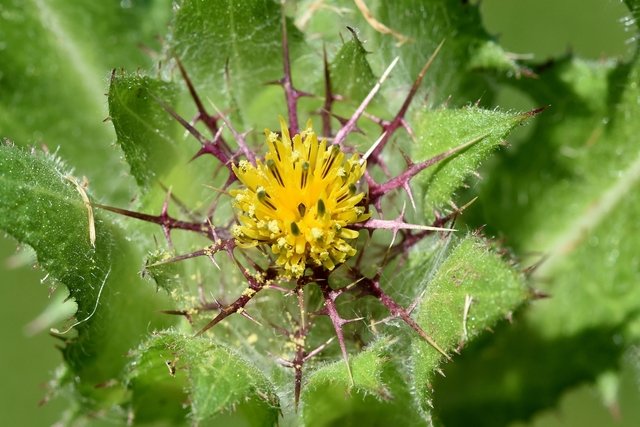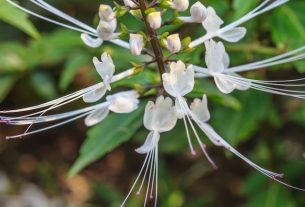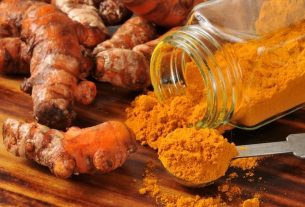Holy thistle is a medicinal plant with anti-inflammatory and digestive properties, which is popularly used to help treat digestive and liver problems.
The holy thistle (Blessed thistle) should not be confused with milk thistle, whose scientific name is Silybum marianum, and which has different properties. These plants can be differentiated by their appearance, since the holy thistle has yellowish flowers with thorns on the margins, similar to a cactus, while the milk thistle has large pink flowers and spiny leaves.
Holy thistle can be purchased in health food stores, compounding pharmacies and in some open-air markets, and should be used under the guidance of a doctor or herbalist.

What is it for
Holy thistle has antiseptic, healing, astringent, digestive, decongestant, stimulating, tonic, expectorant, diuretic, anti-inflammatory, antioxidant and antimicrobial properties, being popularly indicated for:
- Indigestion;
- Pain or discomfort in the stomach;
- Excess stomach and intestinal gases;
- Liver problems;
- Diarrhea;
- Menstrual cramps;
- Loss of appetite or anorexia;
- Wounds or ulcers on the skin;
- Boil;
- Flu and colds;
- Cough;
- Swelling;
- Bacterial infections.
Additionally, it is believed that holy thistle can be used to help increase breast milk production. However, there is no evidence for this use, which is different from milk thistle, which has studies showing that it increases breast milk production. Learn how to use milk thistle to increase breast milk.
Although it has many benefits, holy thistle should not replace medical treatment with medicines or be used without guidance from a doctor or herbalist.
How to make holy thistle tea
The used parts of thistle are the stems, leaves and flowers, and can be used to make teas or compresses, for example.
Ingredients
- 2 tablespoons of dried holy thistle leaves and flowers.
- 1 liter of water.
Preparation mode
Place water in a container and boil. Then, turn off the heat and add 2 tablespoons of dried leaves and flowers to the boiled water. Cover and let rest for 10 to 15 minutes. Then strain, wait for it to cool and twice a day after meals.
As the plant has a very bitter taste, due to the presence of cnicin in its composition, you can sweeten the tea with a little honey.
Thistle tea can also be used to make compresses to apply to the skin, in cases of wounds, hemorrhoids or infections, for example. To do this, you must wet a gauze pad with the tea and place it on the area of skin you want to treat.
Possible side effects
Holy thistle is considered safe when used in recommended amounts, however, when consumed more than 5 grams per day, it can cause nausea, vomiting or stomach pain.
Furthermore, when applied to the skin it can cause skin irritation.
Who shouldn’t use
Holy thistle should not be used by children, pregnant women or people who have Chron’s disease, ulcerative colitis or allergies to this plant.
Furthermore, holy thistle should be used with caution by people being treated with diuretic medications, such as furosemide, for example, or who are using proton pump inhibitor medications, such as omeprazole or lansoprazole, or other antacid medications.
Although holy thistle is popularly used to stimulate milk production, its use is not recommended during breastfeeding, as there is no proof of this benefit.
Furthermore, it is not known whether holy thistle passes to the baby through milk, and the effects it can have on the baby are not known. Therefore, its use during breastfeeding should only be done if recommended by a doctor.
Bibliography
- DRUGS AND LACTATION DATABASE (LACTMED) (INTERNET). BETHESDA (MD): NATIONAL LIBRARY OF MEDICINE (US). Blessed Thistle. 2022. Available at: <https://pubmed.ncbi.nlm.nih.gov/30000834/>. Accessed on October 21, 2022
- SZABÓ, I.; et al. The Antimicrobial Activity of the Cnicus benedictus L. Extracts. Annals of the University of Oradea, Fascicula Biology. 126-128, 2009
- AHMADIMOGHADDAM, D.; et al. Antinociceptive activity of Cnicus benedictus L. leaf extract: a mechanistic evaluation. Res Pharm Sci. 15. 5; 463-472, 2020
- AL-SNAFI, AE The Constituents and Pharmacology of Cnicus Benedictus– A Review. The Parmaceutical and Chemical Journal. 3. 2; 129-135, 2017
- POPOADZKI, P.; et al. Adverse effects of herbal medicines: an overview of systematic reviews. Clin Med (Lond). 13. 1; 7-12, 2013

Sign up for our newsletter and stay up to date with exclusive news
that can transform your routine!
Warning: Undefined array key "title" in /home/storelat/public_html/wp-content/plugins/link-whisper-premium/templates/frontend/related-posts.php on line 12
Warning: Undefined array key "title_tag" in /home/storelat/public_html/wp-content/plugins/link-whisper-premium/templates/frontend/related-posts.php on line 13



